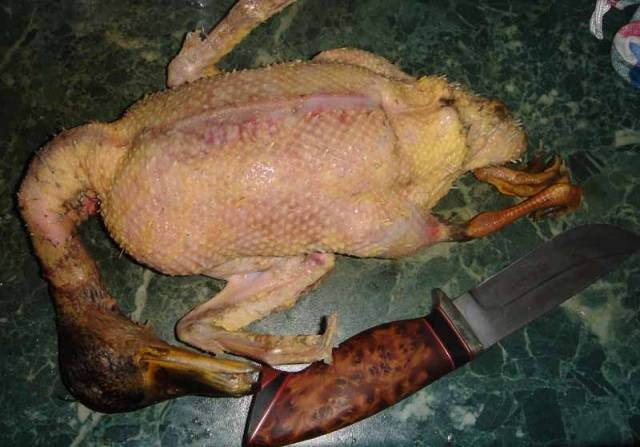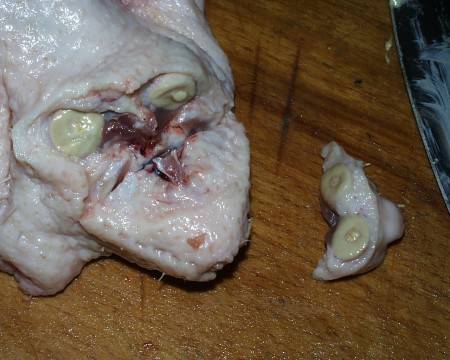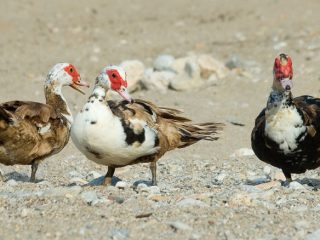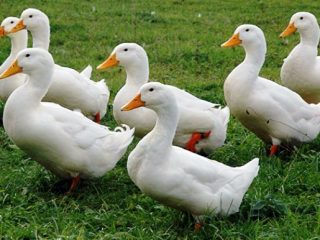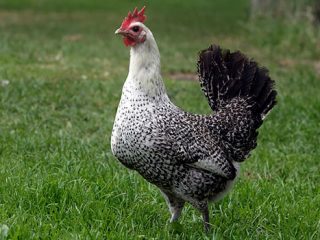Content
To private traders involved duck breeding, every 2-3 months a problem arises: how to pluck a duck. True, before plucking it, the duck must be slaughtered. The slaughter of ducks is only a psychological problem for people who have not dealt with it.
Ducks are slaughtered at the age of 2-3 months. After the ducklings have acquired feathers, but the juvenile molt has not yet begun. A duck killed during the molting period is difficult to pluck properly. There will definitely be stumps left from which new feathers should have grown. If the ducks were not slaughtered at 3 months, they are slaughtered after the end of the juvenile molt.
At 2 months, ducks usually have not yet gained subcutaneous fat and their skin is very thin. The weight of the ducklings is also small, but this is at the discretion of the owner. You need to pluck such a duck very carefully. If you grab too many feathers, they are torn off along with the skin.
To avoid sawing the duck's throat with a dull knife, the weapon is first sharpened. After catching a duck, its throat is cut near the head under the beak. As a result of cutting large blood vessels, the duck goes into shock and no longer feels pain.
How to pluck a duck correctly
The best way to quickly pluck a duck is to place it in a defeathering machine.But this machine costs so much that most owners prefer to do it manually.
There is an opinion that ducks should be left for 4 hours before plucking. Then the feather is better separated from the skin. But we must not forget that decomposition begins very quickly in the heat. And it starts from the intestines.
After slaughter, the duck is placed in a container of boiling water. Usually, each duck owner has his own secrets for “soaking” a duck carcass and then plucking it. One way: immerse the duck carcass in boiling water twice. This works well when you need to pluck an old duck.
Since usually the more fertile young ducks are left for the next year, the “old” ducks have to be slaughtered annually.
Another way to scald a duck is in hot water with a couple of drops of detergent added. It is believed that in this case, the fat is washed off from the duck feathers and plucking the duck at home becomes much easier.
There is also a dry method for plucking a duck carcass. Everything is the same, only without soaking in water. Disadvantages of this method:
- in fact, feathers from a duck carcass are much more difficult to tear out, especially flight feathers from the wings and tail feathers from the tail;
- dry feathers fly everywhere, sticking to hands and clothes.
The advantage of the dry method is better searing of the plucked duck carcass.
But the principles of plucking are the same, so adherents of dry cleaning can skip the step of scalding the duck carcass.
So, the duck carcass is scalded. With or without added detergent. Plucking of ducks is carried out starting with large flight and tail feathers.
After this, the feathers begin to be plucked from the carcass in the direction of growth, since otherwise the skin of a young duck can be damaged. In older ducks, sometimes you have to pluck the feathers in the opposite direction, this makes them easier to tear out. The video shows the process of plucking a duck very well.
Since it is impossible to pluck a duck completely clean either manually or using a machine, after plucking the duck carcass must be singed. The duck is singed either with a blowtorch or on a gas burner. In the latter case, you will have to hold the duck carcass by its legs and wings. When singeing with a blowtorch, you can simply hang the duck from something.
A feather that has absorbed water burns later than the duck skin begins to bubble. To prevent this from happening, the duck must be dried before searing. After scorching, the fumes from the duck carcasses are cleaned off or washed off and proceed to the next stage.
Gutting a duck
The task: to get rid of the intestines without damaging them. When gutting a duck, you need to be careful not to accidentally cut through the intestines.
During this time, the ducks' intestines are almost completely empty of contents.
The most convenient scheme for gutting a duck is when the entire duck intestine remains intact. It's better not to cut it in parts. The contents of the intestines can enter the abdominal cavity of the duck carcass and spoil the meat.
How to properly cut a duck:
- With a knife, an incision is made along the flexor tendons between the metatarsus and the thigh and the duck foot is bent in the direction opposite to the natural one;
- The duck's foot breaks at the joint. The remaining tendons are cut with a knife. Do the same with the second paw;
- lay the duck on its back, with its neck facing you;
- with the hand from below, stretch the skin on the neck;
- A sharp knife is drawn along the neck of the duck, cutting the skin. The fingers will be protected by the neck, but it is better that the knife does not slip;
- pick up the cut skin and tear the skin off the neck:
- The esophagus and trachea are torn off along with the skin. They are torn from the skin to the maximum possible depth inside the duck. That's all from this side;
- turn the duck over with the tail facing you and carefully, with the sharpened tip of a knife, make an incision in the skin from the keel towards the anus, being careful not to touch the intestines;
- stick their fingers into the hole formed and open the cut with their fingers;
- The duck has thin bones closer to the tail. Flatten the skin between the tail and the bone with two fingers and make a transverse incision. When cut on both sides, the anus will be almost separated from the duck tail;
- they grab the anus and intestines and cut it out in the “out of the duck” direction - from bottom to top;
- stick their hand inside the duck carcass, tearing the films connecting the giblets to the body of the duck;
- reach the esophagus and grab it with the middle finger, pinching it between two adjacent ones;
- Using a raking motion, the gastrointestinal tract along with the liver is pulled out of the duck.
The main work is done. The intestines are not damaged and the contents have not stained the duck carcass.
The duck carcass still contains the heart, lungs and trachea. The trachea and heart are removed. The lungs are attached to the ribs and can be removed at will. The heart is washed of blood and kept for itself, the trachea is given to four-legged starving people, if there are any in the house.
Now we need to deal with the stomach and liver. The liver must be carefully separated from the intestines so as not to damage the gallbladder.
The duck gizzard is removed from the intestines and cut open to clean out the contents. The film also needs to be removed. What’s interesting is that the gastric film can be removed very easily, or it can “stick to the last” and this circumstance does not depend on the age of the duck, or on the diet, or on the conditions of keeping the ducklings. But you need to remove the film, it gives bitterness during cooking.
After they have dealt with the insides, they return to the duck carcass. It is also necessary to cut out the sebaceous gland on the duck's tail, since this specific fat will spoil the entire dish with its smell.
There is no meat there, only fat. By carefully cutting the soft tissue around the tail down to the spine, the tail can be easily torn off in a circular motion.
After the duck is gutted, we decide whether it needs to be skinned.
How to skin a duck
The first thing to do is decide whether to do this. If you need to get a fatty dish, you cannot skin the duck. If the goal is to reduce the amount of fat in food, skinning the duck is a must.
All the fat in a duck is concentrated under the skin. By removing the skin from the duck, you get lean meat.
The skin on the duck's neck is rough and the taste is not for everyone. When skinning, you can cut it off along with the skin on the back. On the back we remove the skin as far as it can be removed. It is usually removed approximately to the lower back. Starting from the lower back, there is only fat between the skin and bones, so the skin here will have to be cut off. We removed as much skin as possible from the back of the duck. Now the chest.
We make an incision along the midline on the chest, grab the skin and remove it, helping ourselves to cut the films with a knife. The skin in this place is removed very easily. Next, as far as possible, remove the skin from the sides and legs. The skin of duck wings is very difficult to remove, but there is almost no fat underneath. You can leave the wings on. It is more convenient to boil a skinned duck than to fry it.
Cutting duck into portions
After the duck has been gutted and possibly skinned, it should be cut into portions. It is better to start carving a duck from the legs. Then it will be better to see where to trim the fillet meat. If there is skin, it is cut at the junction of the leg and body. After this, the duck leg is turned out of the hip joint and the remaining tendons and skin are trimmed.
The loin parts are cut along the keel bone and the fork bone (in duck it is semicircular) and the meat is separated from the skeleton. The muscles near the wing are trimmed. The fillet is also ready.
The wings, like the legs, are cut at the joint. These pieces will make up the portions for the roast.
Housewives usually decide for themselves how to cut up a duck. Sometimes fillet and wing act as a portioned piece at the same time. Someone cuts a duck into two halves. And someone, when cutting into portioned pieces, cuts off the wings for soup.
Everything that remains after cutting the duck goes into the soup set category. Later, you can make soup from the duck leftovers.
Conclusion
The ability to pluck and gut ducks is very useful for those who want to get a couple of kilograms of very tasty and healthy meat. At the same time, it is not even necessary to know how to cut duck carcasses into portioned pieces. A whole grilled duck is also very tasty.



